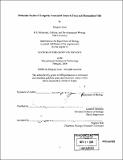Molecular studies of longevity-associated genes in yeast and mammalian cells
Author(s)
Liszt, Gregory (Gregory Birjandi)
DownloadFull printable version (17.44Mb)
Other Contributors
Massachusetts Institute of Technology. Dept. of Biology.
Advisor
Leonard Guarente.
Terms of use
Metadata
Show full item recordAbstract
Aging is a complex process affecting diverse organisms from bacteria to humans. Despite strong evolutionary arguments against the conservation of a single mechanism of aging, a variety of conserved single gene mutations have been found to extend life span and stave off aging in several different species. The study of these mutations yields important insights into the biology of aging. In Saccharomyces cerevisiae, aging can be studied by mutations that extend the replicative potential of mother cells. With successive cell divisions, instability at the rDNA locus and extrachromosomal rDNA circle accumulation exponentially increase the likelihood of senescence and mortality. Aging can be forestalled by caloric restriction, a regimen that increases the activity of Sir2p, an NAD-dependent protein deacetylase and important regulator of aging in yeast and some metazoans. Caloric restriction activates respiration, reducing cellular NADH levels and relieving the competitive inhibition of Sir2p by this metabolite. SSD1 promotes longevity by a Sir2p-independent mechanism that affects neither ERC formation nor rDNA silencing. Ssd1p directly represses the translation of the mitochondrial and cell wall glycoprotein Uthl. (cont.) This repression, which requires a physical interaction between Ssdlp and the 5'-UTR of the UTH1 mRNA, is necessary and sufficient to account for diverse effects of Ssdlp on cell integrity, stress resistance, and life span. Future studies should determine whether Ssd1 plays a role in the maintenance of longevity in higher organisms. Mammalian genomes contain seven Sir2 homologs (SIRT1-7) involved in diverse processes including fat and muscle cell differentiation, p53- and FOXO-dependent apoptosis, stress resistance, and DNA-damage repair. Mouse SIRT6, a nuclear protein, is broadly expressed throughout the body and displays a robust auto-ADP- ribosyltransferase activity unique among Sir2 family members. SIRT7, a nucleolar homolog of Sir2, physically interacts with RNA polymerase I (Pol I), colocalizing with the Pol I complex at the transcribed regions of the rDNA. SIRT7 activates rDNA transcription by an enzymatic mechanism, suggesting a novel model coordinating cellular energy status with ribosome biogenesis via changes in SIRT7 activity.
Description
Thesis (Ph. D.)--Massachusetts Institute of Technology, Dept. of Biology, February 2006. Includes bibliographical references.
Date issued
2006Department
Massachusetts Institute of Technology. Department of BiologyPublisher
Massachusetts Institute of Technology
Keywords
Biology.